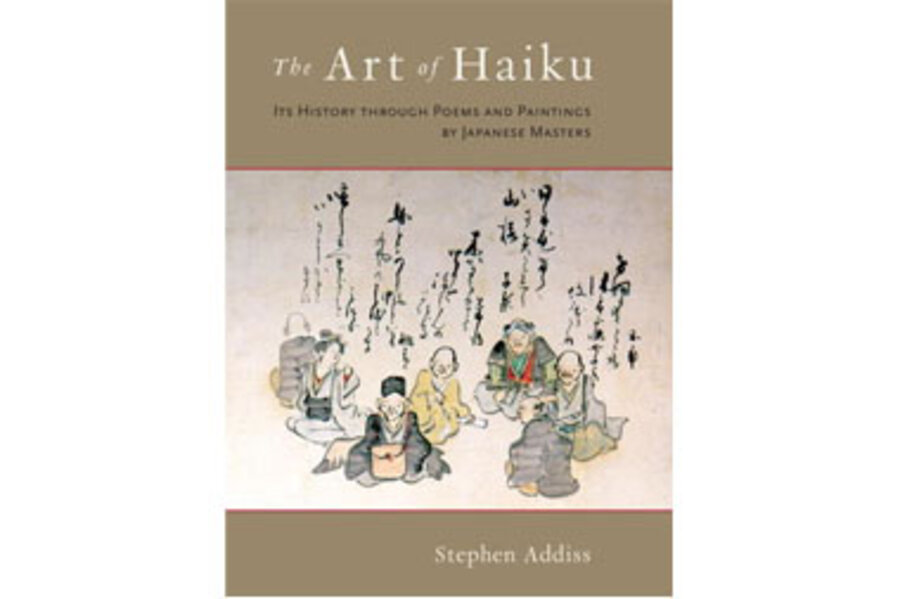The Art of Haiku
Loading...
There is hardly a schoolchild who is not familiar with haiku, the Japanese art of the tiny poem, constructed out of three lines of 5-7-5 syllables and traditionally evoking images from nature. But while an understanding of haiku is often left at that, its legacy in art and literature is decidedly more complex. In The Art of Haiku, Stephen Addiss illuminates how haiku evolved in the hands of its masters, stretching from the eighth century to the 12th. He purposefully juxtaposes the well-known poetic form with its less famed artistic counterparts: paintings, called haiga, and calligraphy. Fully formed haiku was meant to be experienced both visually and textually. This uncommon book gives us the chance to do just that.
Addiss is the right man to author “The Art of Haiku.” He is not only a leading haiku scholar, but also a practicing artist who has exhibited ink paintings and calligraphy around the world. He translates from Japanese, and has a lengthy list of publications. Fittingly, as haiku has its roots in song, Addiss traveled the world as part of the folk music duo Addiss & Crofut. He studied music at Harvard University and, with composer John Cage, at the New School in New York. He didn’t begin his graduate work on East Asia until he was in his late thirties.
Fascinating as Addiss himself is, he keeps out of the spotlight in “The Art of Haiku.” The book is a steady narration on the emergence of haiku, beginning with the courtly tradition of tanka (five-line poems – or songs – of 5-7-5-7-7 syllables) and evolving into new forms, including haiga, haikai (comic verse), and renga, where two or more poets go back and forth to create a chain of linked tanka, shaped by a range of curious rules. “Chinese-derived words were frowned upon, but seasonal references should be included in roughly half the segments […],” Addiss informs us. Some words could only appear once in a thousand verses, including the words for demon, tiger, dragon, and woman.
The book is rich with poems – 997 haiku, nearly all translated by Addiss and integrated easily with the text alongside transliterated Japanese originals. Particularly fascinating is the discussion of haiku translation. Idiosyncrasies in the originals, such as pause marks called kijeri (literally, cutting words) leave room for translators to make judgment calls on how to evoke rhythm or amplification. Addiss encourages readers to sound out the Japanese originals – and provides the tools to do so – to hear the music, and he does so with a grace that does not undercut the worth of the gorgeous English versions. He arms readers with a wealth of context on how, for example, the Japanese word for “color” and “passion” is the same. Like the art of haiku itself, Addiss invites readers into the poems, amplifying them with their own experiences and, in a way, collaborating with the poet to complete the poem.
There is even an appendix on translation, which sets forth yet more choices in moving haiku between Japanese and English. Addiss presents a haiku by Chiyo in Japanese and lists each word with its literal meaning before indicating that, “Now it is up to you: Will you try to make this a 5-7-5 poem in English? Will you change the line order? Will you use any plurals? What words and rhythms in English do you think can convey this scene best?”
What might seem gimmicky is actually an endearing manifestation of how Addiss writes this book as a meeting-of-equals between author, readers, artists, and poets. And what company to keep! There is Lady Murasaki, author of “The Tale of Genji” (probably the world’s first novel), whose title character trades whispered tanka with his wife. There is Saigyō Hōshi, who leaves his luxurious life in the imperial guard to become a Buddhist monk and write searing poems of transience. There is Yosa Buson, the master especially skilled in haiga (he knew it, too). His paintings reproduced here are drawn so simply and sweetly, they look like the figures of comics: emotion is evoked in just a few lines (which is, of course, the same formula for haiku). Kobayashi Issa funneled a tragic life into tiny potent verses. And of course there is Bashō, the wandering poet who, as Addiss puts it, is to haiku what Shakespeare is to theater and Michelangelo is to sculpture.
There are times when the clear language of “The Art of Haiku” turns bland, more like the rote recitation of a lecturer than a writer delving into poetic treasures. Addiss’ thorough explanations subdue his enthusiasm: when he does break the even tone to describe a poem as “charming” or “powerful,” it is hard to feel any heat behind it. There are needless textual repetitions that add to the classroom feel – the interesting bit about “color” and “passion” being the same word in Japanese is mentioned three times in eight pages. At its worst, one wonders at the dissonance between the textbook language and the heart-opening art it means to conjure.
At its best, however, Addiss’ strategy of keeping his own voice muffled (he uses the pronoun “we” rather than “I”) creates room for the ambitious scope of “The Art of the Haiku,” allowing several centuries worth of poets and artists to hold court without distraction. And, indeed, there they shine.
Anna Clark is a freelance writer in Detroit.








